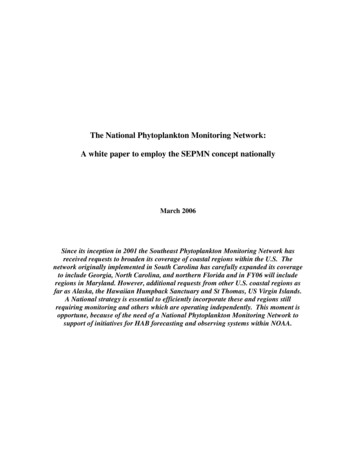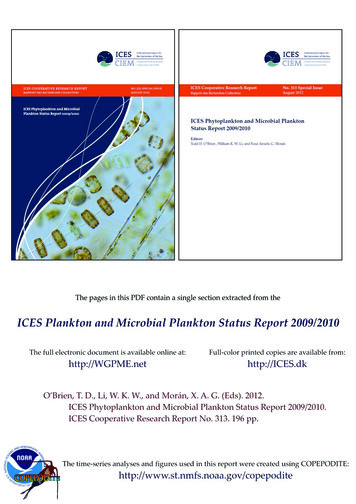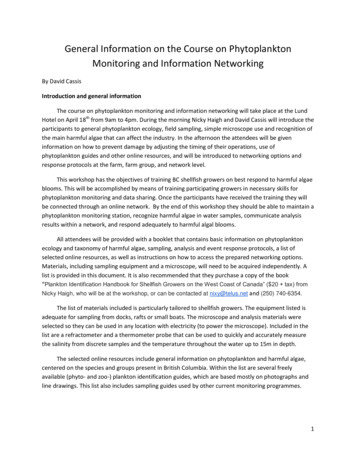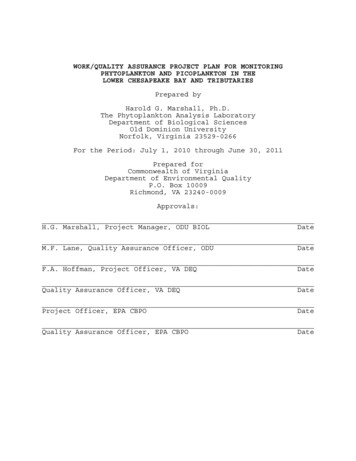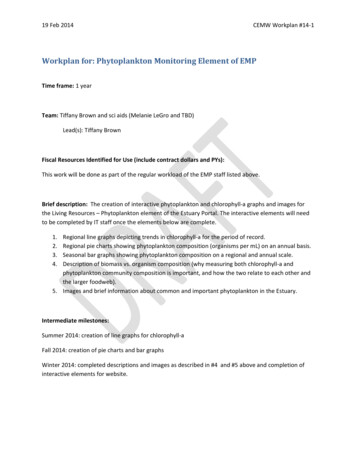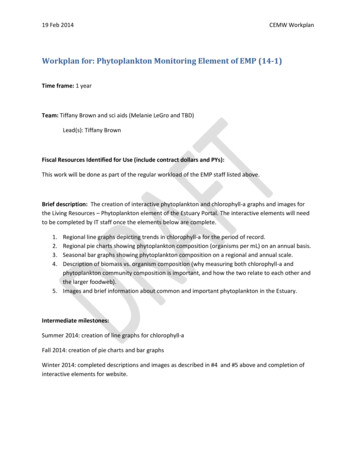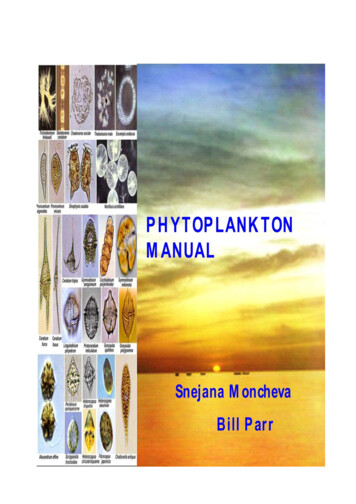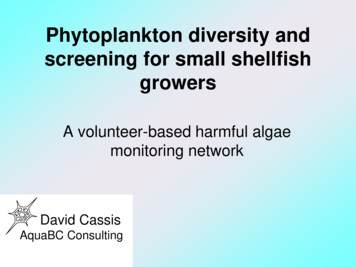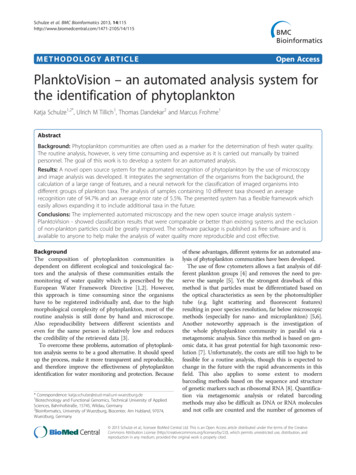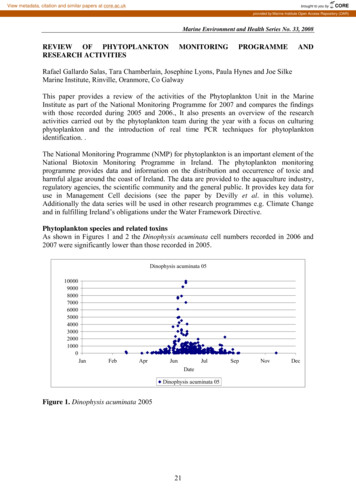
Transcription
View metadata, citation and similar papers at core.ac.ukbrought to you byCOREprovided by Marine Institute Open Access Repository (OAR)Marine Environment and Health Series No. 33, 2008REVIEW OF PHYTOPLANKTONRESEARCH ACTIVITIESMONITORINGPROGRAMMEANDRafael Gallardo Salas, Tara Chamberlain, Josephine Lyons, Paula Hynes and Joe SilkeMarine Institute, Rinville, Oranmore, Co GalwayThis paper provides a review of the activities of the Phytoplankton Unit in the MarineInstitute as part of the National Monitoring Programme for 2007 and compares the findingswith those recorded during 2005 and 2006., It also presents an overview of the researchactivities carried out by the phytoplankton team during the year with a focus on culturingphytoplankton and the introduction of real time PCR techniques for phytoplanktonidentification. .The National Monitoring Programme (NMP) for phytoplankton is an important element of theNational Biotoxin Monitoring Programme in Ireland. The phytoplankton monitoringprogramme provides data and information on the distribution and occurrence of toxic andharmful algae around the coast of Ireland. The data are provided to the aquaculture industry,regulatory agencies, the scientific community and the general public. It provides key data foruse in Management Cell decisions (see the paper by Devilly et al. in this volume).Additionally the data series will be used in other research programmes e.g. Climate Changeand in fulfilling Ireland’s obligations under the Water Framework Directive.Phytoplankton species and related toxinsAs shown in Figures 1 and 2 the Dinophysis acuminata cell numbers recorded in 2006 and2007 were significantly lower than those recorded in 2005.Dinophysis acuminata AprJunJulDateDinophysis acuminata 05Figure 1. Dinophysis acuminata 200521SepNovDec
Proceedings of the 8th Irish Shellfish Safety Workshop, Galway, 5th December 2007Dinophysis acuminata Cell counts 2006 & eDinophysis acuminata 06Dinophysis acuminata 07Figure 2. Dinophysis acuminata 2006 and 2007The pennate diatom Pseudo-nitzschia spp. is known to produce Domoic acid, the primarytoxin causing Amnesic Shellfish Poisoning. Figures 3 & 4 show the cell counts of Pseudonitzschia spp. for the last 3 years. . Pseudo-nitzschia spp. for practical reasons has beenseparated into two groups: the seriata group and the delicatissima group. Species from bothgroups can actually be toxic, but they are very difficult to identify to species level when usingconventional light microscopy, so a pragmatic approach has been used to narrow down thespecies by grouping them in this manner.Pseudonitzschia seriata group 2005 to nJulSepDateP.seriata group 2005P.seriata group 2006Figure 3. P. seriata cell counts 2005, 2006 & 200722P.seriata group 2007NovDec
Marine Environment and Health Series No. 33, 2008Pseudonitzschia delicatissima group 2005 to nJulSepNovDecDatePseudo-nitzschia delicatissma group 2005Pseudo-nitzschia delicatissima group 2007Pseudo-nitzschia delicatissma group 2006Figure 4. P.delicatissima group cell counts 2005, 2006 & 2007The data presented shows that the density of these species over the last 3 years has notchanged significantly. It shows that these species are very cosmopolitan and conspicuous,occurring throughout the year but in greater numbers typically during the spring bloom inApril and during the summer months. However in 2005 the levels of Domoic acid in musselsfor the SW coast exceeded the regulatory limit in early April (Clarke et al., 2005) but this didnot occur in either 2006 or 2007. This indicates that cell numbers of Pseudo-nitzschia spp.alone are not a good indicator of the onset of ASP toxicity and that it essential to identify theorganism to species level in order to better evaluate the risk. To this end the PhytoplanktonUnit is developing gene probes coupled with Real time PCR techniques to enable such data tobe collected on a routine basis. (See the paper by Kavanagh et al this volume).In Ireland the occurrence of PSP toxins in shellfish is mainly confined to PSP in to the Corkharbour area, where shellfish, principally mussels, become toxic usually for a short period of1 -2 weeks in June . In 2007 PSP toxins were detected in mussels from Cork Harbour in lateJune and early July. The levels of Alexandrium cells in the water were quite low compared to2006 (Figures 5 and 6).Alexandrium spp. ndrium spp. 2006Figure 5. Alexandrium spp. cell counts in 200623SepOctDec
Proceedings of the 8th Irish Shellfish Safety Workshop, Galway, 5th December 2007Alexandrium spp. ebAprJunJulSepOctDecDateAlexandrium spp. 2007Figure 6. Alexandrium spp. cell counts in 2007Azaspiracid (AZA) was first discovered in 1995 and Protoperidinium crassipes, taken fromplankton net hauls off the SW coast of Ireland, has been reported to be the causative organism(James et al 2004). However, Protoperidinium spp. are heterotrophic organisms and couldtherefore accumulate the toxin through feeding upon the true progenitor, which could explainthe poor correlation between the levels of Protoperidinium spp and the levels of AZAsdetected in shellfish. Figures 7 & 8 show that Protoperidinium spp. are cosmopolitan butubiquitous in Ireland, most times occurring in low cell numbers all throughout the year. In2007 AZA was detected in shellfish at levels above the regulatory limit in October andNovember but no clear link is apparent between this AZA event and the cell numbers ofProtoperidinium spp recorded at the same time.Minuscula bipesProtoperidinium brevipesProtoperidinium conicumProtoperidinium crassipesProtoperidinium curtipesProtoperidinium curvipesProtoperidinium depressumProtoperidinium excentricumProtoperidinium leonisProtoperidinium mariaelebouraeProtoperidinium oblongumProtoperidinium oceanicumProtoperidinium ovatumProtoperidinium pallidumProtoperidinium pellucidumProtoperidinium pentagonumProtoperidinium pyriformeProtoperidinium steiniiProtoperidinium subinermeProtoperidinium spp. 200645004000350030002500200015001000500DateFigure 7. Protoperidinium spp. 200624JNOAJMMFD0
Marine Environment and Health Series No. 33, 2008Protoperidinium spp. 20077000Minuscula bipesProtoperidinium brevipesProtoperidinium conicumProtoperidinium crassipesProtoperidinium depressumProtoperidinium leonisProtoperidinium mariaelebouraeProtoperidinium minutumProtoperidinium pallidumProtoperidinium pellucidumProtoperidinium punctulatumProtoperidinium pyriformeProtoperidinium steinii600050004000300020001000NSAJAMJN0DateFigure 8. Protoperidinium spp. 2007Temperature monitoringThe Marine Institute maintains a network of temperature probes (TidBits ) at 11aquaculture sites around the coast. Each site has several sensors attached to nets or buoys atdifferent depths and they measure temperatures hourly over a period of several months beforethe data needs to be downloaded. This data is a comprehensive time series of temperature dataaround the coast of Ireland, which can be accessed through our website www.marine.ie .Figure 9 shows an example of temperature time series for the past 4 years from KillaryHarbour, County Galway. In 2007 water temperatures were generally lower than in previousyears and only exceeded 14oC for a shorter period compared with the 2004 – 2006.Killary Harbour20042005200614 Figure 9. Killary Harbour temperature data since 2004.252007
Proceedings of the 8th Irish Shellfish Safety Workshop, Galway, 5th December 2007Research ActivitiesThe Marine Institute’s Phytoplankton Unit has been involved over the years and continues itsinvolvement in number of collaborative research projects at an international and nationallevel. In the past we have been working closely in projects including BOHAB, MATSIS,METRIC and others. At present we are collaborating in a project called PHYTOTEST whichinvolves the development of gene probes to assist in the identification of toxic/harmful marinephytoplankton species. Details of this project are presented in the paper by Kavanagh et al inthis volumeAs well as working in this project, the phytoplankton unit staff since the move to the newHeadquarters at Rinville, Oranmore, County Galway, have been working and developing theirskills in the new culture unit for phytoplankton. The new facilities include a walk-inincubator, several stand alone incubators, a laminar flow hood and a dedicated and fullyoperational culture lab (Plate 1)Plate 1. MI Phytoplankton Culture facilitiesA significant effort has been made over the last 2 years to culture ecologically importantmarine phytoplankton species. Some 30 strains of mostly toxic and harmful phytoplanktonspecies have been established and used for a number of research projects. The cultures havebeen used in morphological studies, life history studies, toxicological studies, molecularstudies but also for teaching and demonstration purposes.At present the culture unit is attempting to culture Dinophysis spp. Attempts at culturingDinophysis spp. had failed over the years but in 2006 a Korean research group successfullycultured this species for the first time (Park et al., 2005) The process involves feedingDinophysis with a ciliate (Myrionecta rubra), this ciliate in turn would have to be fed with thecryptophyte (Teleaulax acuta) (See Plate 2).Teleaulax amphioexaMyrionecta rubraD. acuminataPlate 2. Pictures of organisms involved in the culture of Dinophysis acuminata26
Marine Environment and Health Series No. 33, 2008In collaboration with colleagues D. Kulis and D. Anderson from the Woods HoleOceanographic Institute work is ongoing to culture D. acuta and D. tripos D. acuta has beenmaintained in culture for the past 5 months and feeding and division has been recorded. Thesmall cells of D. acuta are very similar to Dinophysis dens cells and it is possible that they arethe same species at different stages of their life cycle. In addition we have a 3 month oldculture of D. tripos and we have also observed feeding and reproduction giving way to smallcells as has been observed with D. acuta. It is likely that, in the near future, the genusDinophysis will have to be taxonomically completely revised.The phytoplankton lab is also trying to isolate and culture organisms that produceAzaspiracid. This is done by obtaining live samples from AZA affected areas and carrying outfractionation of the sample to the smallest mesh possible (1µm). Cultures of the fractions arebulked up and analysed using advanced LCMS techniques (Figure 10).Protoperidinium crassipesFigure 10. Fractionation of live samples through mesh.As well as culturing phytoplankton, the phytoplankton unit is part of the molecular biologyfacility in the MI. This unit was established recently, this year a real time PCRinstrument hasbeen commissioned and is functioning at present. Phytoplankton personnel have startedtraining in molecular techniques and our aim is to use these molecular tools to identify toxicphytoplankton found in the Irish coastal waters, create a database of Irish strains andultimately develop gene probes as a risk management tool for the phytoplankton monitoringprogramme.ReferencesClarke D., Devilly L., McMahon T., O’Cinneide M., Silke J., Burrell S., Fitzgerald O., HessP., Kilcoyne J., McElhinney M., Ronan J., Gallardo Salas R., Gibbons B., Keogh M.,McCarron M., O’Callaghan S., Rourke B., (2005) A Review of Shellfish ToxicityMonitoring in Ireland & Review of Management Cell Decisions for 2005. Proceedingsof the 6th Irish Shellfish Safety Workshop, Marine Institute Galway, December 2005James K., Diaz Seierra M., Lehane M., Brana Magdelena A., Moroney C., and Furey A.(2004) Azaspiracid poisoning:aetiology, toxin dynamics and biocobversion in shellfishin Steidinger K., Landsberg C., Tomas C. and Vargo G (Eds) Harmful Algae 2002.Florida Fish and Wildlife Conservation Commission, Florida Institute of Oceanographyand IOC of UNESCO pp111-112Park M.G., Kim S., Kim H. S., Myung G., Kang Y.G., Yih W., (2006) First successful cultureof the marine dinoflagellate Dinophysis acuminata. Aquatic Microbial Ecology Vol. 45:101–106, 200627
The phytoplankton monitoring programme provides data and information on the distribution and occurrence of toxic and harmful algae around the coast of Ireland. The data are provided to the aquaculture industry, . The Marine Institute maintains a network of temperature probes (TidBits ) at 11 aquaculture sites around the coast. Each site .
